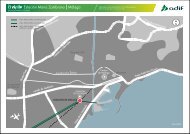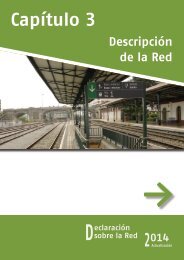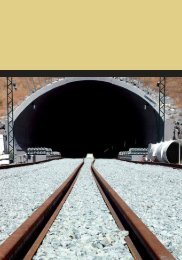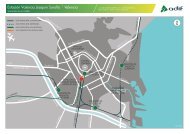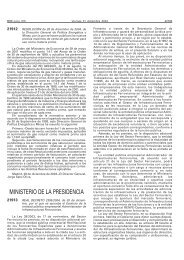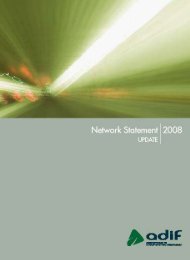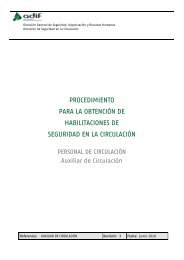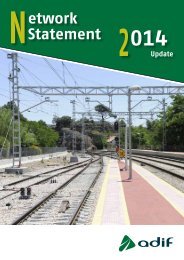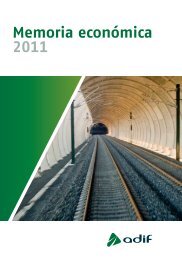Chapter 3 - Adif
Chapter 3 - Adif
Chapter 3 - Adif
You also want an ePaper? Increase the reach of your titles
YUMPU automatically turns print PDFs into web optimized ePapers that Google loves.
Blocking<br />
Automatic Control Block System (BCA)<br />
Safety distance is kept regulating the train speed, never<br />
exceeding the speed limit that the driver continuously<br />
receives via cab signaling. There are various systems of BCA<br />
in <strong>Adif</strong> Managed Network. The section corresponding to<br />
safety systems shows the various systems available.<br />
Side Signal Block System (BSL)<br />
A safe distance between trains is ensured by signal<br />
indications. It is similar to the BA listed below, though<br />
specific of high-speed lines.<br />
Automatic Release Block System (BLA)<br />
This blocking system generally has one-block section<br />
between stations, which is protected automatically by<br />
signals and axle counter devices.<br />
Depending on the track and signaling conditions, there are<br />
several types of Automatic Release Block System, similar to<br />
the Automatic Block System, described as follows.<br />
Automatic Block System (BA)<br />
It generally has intermediate block sections between<br />
stations, which are automatically protected by signals.<br />
Depending on the signaling and track conditions, there is a<br />
Single-Track Automatic Block System (BAU), a double track<br />
Automatic Block System (BAD), and an Automatic Pooled<br />
Block System (BAB).<br />
Radio Traffic Control (CCR)<br />
This block system is used on lines with little traffic, and train<br />
traffic is ensured by a permanently reporting to the Head of<br />
CCR of the status of the trains on sections, of authorizations<br />
given to drivers and notice of train arrivals. Closed radio<br />
communications are used.<br />
Manual Electric Block (BEM)<br />
Track blocking is made by Traffic Managers through an<br />
electrical device.<br />
Telephone Block (BT)<br />
Blocking the section between two open stations is ensured<br />
by telephone messages sent between Operating Managers.<br />
The existing blocks on every line are included in Map 12,<br />
Annex H.<br />
3.3.3.2. Automatic Train Protection<br />
Systems<br />
Train traffic on certain lines may require motor vehicles to<br />
be equipped with any of these ATP systems, as indicated<br />
in the Capacity Manual. ASFA is installed on all main lines<br />
of General Interest Rail Network, RFIG, managed by <strong>Adif</strong>,<br />
and it might be mandatory that rolling stock running on the<br />
network is equipped with it and operates it during service. It<br />
is also mandatory for trains to run on a single-agent regime.<br />
Detailed in Annex H Map 13 are the lines that are equipped<br />
with these systems.<br />
ERTMS<br />
Traffic control, signaling and assisted operation system that<br />
meets European standards of interoperability. It currently<br />
combines two subsystems: ETCS (European Traffic Control<br />
System focused on signaling and train protection), and<br />
GSM-R (Global System for Mobile Communications in<br />
Railways performing communications).<br />
LZB<br />
Control, signaling and driving assistance system that<br />
continuously monitors train speed and controls its running<br />
service via cab signaling.<br />
ATP-EBICAB<br />
This family of protection systems is based on providing<br />
timely information about balises installed on track for<br />
continuous speed supervision.<br />
ASFA, Announcement of Signals and Automatic<br />
Braking<br />
The system announces in cab signal indications through<br />
balises, setting speed controls based on these indications.<br />
This system in its most modern development is called ASFA<br />
Digital.<br />
3.3.3.3. Traffic Control and<br />
Management Systems<br />
Da Vinci<br />
Control and Management Platform that integrates and<br />
centralizes subsystems of signaling, electrification,<br />
communications, etc. enabling their remote monitoring and<br />
communication.<br />
CTC, Centralized Traffic Control<br />
A platform in a central control station centralizes interlocking<br />
and blocking of a line or area.<br />
CRC, Control and Regulation Centre<br />
Centre that manages, organizes and coordinates rail traffic<br />
and safety systems.<br />
PRO, Regional Operations Office<br />
Centre where it is possible to manage exclusively an<br />
interlocking of a line facility, by CRC transfer. It is considered<br />
a second level of traffic control.<br />
PLO, Operations Local Office<br />
Centre where it is possible to manage traffic of a line section,<br />
by CRC transfer. It is considered a third level of traffic control.<br />
48<br />
Network Statement Update 2014 V.0



